
This little page is very far from claiming to be an exhaustive account of any aspect of Egypt's present life. Each of these aspects has a bibliography of its own, each of them to those who seek to acquire expert knowledge, might well be the subject of a lifetime of study and research. 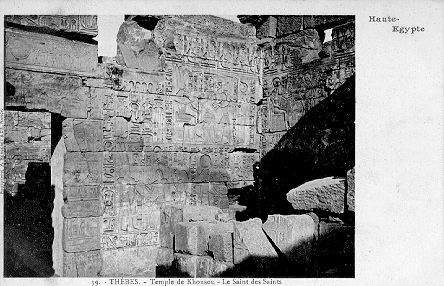 To
say so is to state a truism, a truism which is all the more true when broaching
the subject of the History of Egypt. If there be lands of which the history
may be summarized in a few short pages, Egypt, the oldest country in the
world, is assuredly not one of them. Her written records date far back
into the mists of time and of the races which inhabit the earth there is
none of which there is so much to tell as of the race that dwelt and dwells
on the banks of the Nile. To
say so is to state a truism, a truism which is all the more true when broaching
the subject of the History of Egypt. If there be lands of which the history
may be summarized in a few short pages, Egypt, the oldest country in the
world, is assuredly not one of them. Her written records date far back
into the mists of time and of the races which inhabit the earth there is
none of which there is so much to tell as of the race that dwelt and dwells
on the banks of the Nile.
The most that can be attempted in the limited space here available is a brief chronological outline of the main events of Egyptian history. Pharaonic Egypt is the first stage. Its history is known to cover some three thousand years but it is certain that long before the first known date (3200 B.C.) the inhabitants of Egypt had attained some measure of civilisation. It is however upon Menes, first sovereign lord of Upper and Lower Egypt, that falls the distinction of being the earliest remembered ruler of this ancient land. With Menes we enter upon the first Dynasty of the Ancient Kingdom which, with its eight dynasties, was to endure untill 2100 B.C. That great scientific knowledge was available to the ancient Egyptians of Menes' time is proved by the monuments which remain of a dynasty (the third) comparatively close to his own. Under Zoser (2780-2720 B.C.) the Step Pyramid at Saqqara was built and a hundred years later Cheops raised the Great Pyramid of Giza, that majestic structure which remains a wonder of the twentieth century just as it was one of the seven wonders of the ancient world. 
Menes had welded together the lands of Upper and Lower Egypt. For a thousand years they remained united but in time, while the sixth dynasty still reigned at Thebes, rival kings were ruling the North. Not until the era of the Middle Kingdom (2100-1700 B.C.) was Egypt again united and with unity a new era of glory and prosperity set in. As far south as Ethiopia Egyptian domination held sway; quarries and mines yielded up their wealth; a dam was built to control the waters of Lake Moeris (Fayoum Province). The obelisk at Mataria (Heliopolis of ancient history) is one of the best-known monuments of the Middle Kingdom. The period produced its great kings -Ammenemes and Senwosri are notable examples -and, according to ancient historians, many great monuments were erected. Of these however comparatively few have survived. 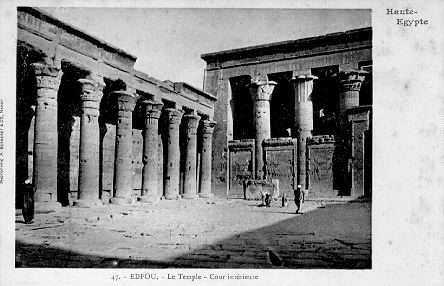 Then
came the Hyksos or Shep herd Kings. One of these, it is thought, was the
Pharaoh who appointed Joseph as his vizier. The Hyksos period was comparatively
short (1700-1555) but their monuments and scarabs are found all over Egypt.
They were overthrown by Amosis, third king of the seventeenth dynasty with
whose reign the New Kingdom (1555-712 B.C.) was ushered in. Then
came the Hyksos or Shep herd Kings. One of these, it is thought, was the
Pharaoh who appointed Joseph as his vizier. The Hyksos period was comparatively
short (1700-1555) but their monuments and scarabs are found all over Egypt.
They were overthrown by Amosis, third king of the seventeenth dynasty with
whose reign the New Kingdom (1555-712 B.C.) was ushered in.
This, frequently referred to as the New Empire, was a great and glorious period of Egyptian history. The empire comprised all land between the Nile and the Euphrates and, from North to South, the entire valley of the Nile. From this period date the beautiful temples of Luxor, Karnak and Deir el Bahari. The second of these was built by Thutmosis III, the first known Emperor, perhaps the greatest of Pharaohs. He reigned for fifty-four years, fought seventeen campaigns and left Egypt as flourishing as she was powerful. 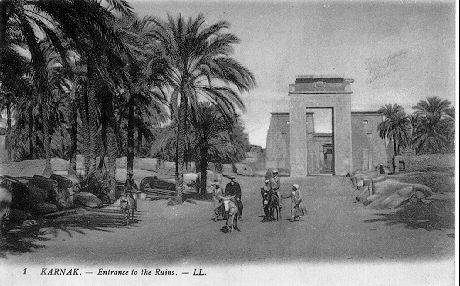
His successors were less successefuI. Architecture and the arts stilI flourished but power was waning. One hundred years after the great Thutmosis, Amenophis IV quarrelled over religious matters with the High Priest of Amon Re. He closed the latter's temples and changed his own name to Akhen-Aten. The King's doctrine died with him and his successor Tutankhamen returned to the old faith. After Tutankhamen (1358-1350 B.C.), the discovery of whose tomb is one of the landmarks of the present century, came a new dynasty, the nineteenth. Of this the celebrated Ramses II is one of the greatest monarchs. He reigned for sixty-seven years, fought numerous wars and died in 1225 B.C. More dynasties came and went. Under the twenty-second dynasty a princess of Egypt was given in marriage to King Solomon. One is struck by the long history of Egypt when it is realised that in those distant Biblical days records of Egyptian history were already more than two thousand years old. A century and a half later King Necho of Egypt fought Nebuchadnezzar on the banks of the Euphrates. Defeated he returned to Egypt, where he devoted his great abilities to internal administration. He was the first to plan a canal for ships between the Red Sea and the Mediterranean. The project lay dormant for twenty-five centuries until it was taken up and carried out by Ferdinand de Lesseps. We now come to the period of the Persian invasion. Cambyses, son of the illustrious Cyrus of Persia, descended upon Egypt in 525 B.C. His conquest was swift, brutal and short-lived. Within two years he was dead and his son Darus reigned in his stead. The Persian domination lasted until 332 B.C. when Alexander of Macedonia appeared and was hailed as a deliverer by the Egyptian nation which had suffered and groaned under the Persian yoke. 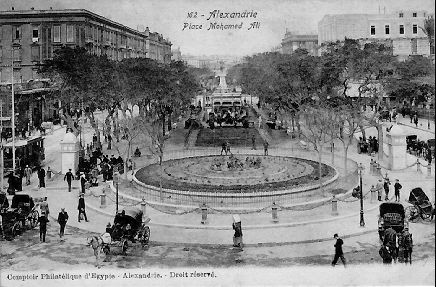
It was as satraps or viceroys of Alexander and his successors that the Ptolemies reigned over Egypt. But they wielded a very large power of autonomy and to the first Ptolemy, the city of Alexandria owes its existence. Named after the illustrious conqueror, it rapidly became one of the centres of the ancient world with its School (Mouseion), its great Library and its famous lighthouse. Nothing remains of those glories. Alexandria, for centuries the Queen of the Mediterranean, was to know ruin and decay. Who, in the spacious days of the first Ptolemy could have predicted so unlikely a calamity or, still less, that Alexandria would, long centuries afterwards, rise from her ashes ? Yet both these things came to pass. Ptolemy Philadelphus and Euergetes followed the first Ptolemy. The former made an attempt, the first of many, to fuse the religion of ancient Egypt with that of Greece. To the latter posterity owes the marvel-lous temple of Edfu. The centuries rolled by and, in the north, the star of Rome was in the ascendant. From Rome, after the death of the last legitimate Ptolemy (Lathyrus), was dictated to Alexandria the choice of Alexander. He was unpopular and his reign was brief. His successor, Neos Dionysos, paid increasing court to the power that was Rome. When he died in 51 B.C. he left his kingdom to be shared by his son Ptolemy and his daughter Cleopatra. The story of Cleopatra, her fight for supremacy, is a long and interesting one. But the romance of her life is one which, striking the imagination has made of Cleopatra's name a household word. Yet she it was who caused Egypt's subjection to Rome and, at her death, a new era opened Ancient Egypt was no more. Rome and Byzance were to hold sway until the Arab conquest of Egypt, seven centuries later. Roman rule had at least the merit of being firm. The anarchy and disorder which preceded it had had disastrous effects on the economy of Egypt: land lay fallow, trade was at a standstill. This, in Roman eyes, was a serious matter. Egypt was the granary of the world and it depended upon Egyptian corn whether Rome went hungry or not. A form of settled government was therefore installed and under Trajan and Hadrian (A.D. 98-138) Egypt regained a measure of her former prosperity. Meanwhile Christianity had arisen and at Alexandria Pantaeus founded the school from which emerged the early fathers of the new Church. Religious persecution followed and revolts broke out which brought Diocletian himself hot-haste from Rome. He subdued rebellion but showed himself merciful and just according to the standard of those far-off days. Alexandria in gratitude erected in his honour the column which, still standing, is known as "Pompey's pillar". The ensuing centuries are a long record of religious strife. Christianity had supplanted the gods of ancient and hellenist Egypt, its victory involving alas ! the destruction of Alexandria's Mouseion and her worldfamed library. Quarrels followed between the Egyptian Church and that of Byzantium and, in the seventh century, Cyrus, archbishop and prefect, attempted to settle the dispute. He failed, resorted to persecution of the Egyptian Church, and by the misery he thus created he made a change of rule a welcome suggestion to Egyptian minds. When in 641 Amr Ibn el As invaded Egypt there was little resistance on the part of a discontented population. Wthin a very short period had become what she is to-day, a part of the
Islamic World. --Amr Ibn el As, a lieutenant of the Khalif Omar, had secured,
not without difficulty, his sovereign's consent to the invasion of Egypt.
He set out from Gaza in Palestine in A.D. 638 and within three years the
conquest
 ed Dur. From her pilgrimage, "bearing rich gifts", to the holy cities of Mecca and Medina sprang the custom, still extant, of sending the Holy Carpet to Mecca. She had seized the reins of power in order to save the Fatimid Dynasty -Turanshah, the murdered Sultan was her stepson -but soon after her death Beibars mounted the throne. Beibars was a great ruler and conqueror. His conquests were decisive.
A man of prodigious physical strength he is said to have swum across the
Nile in full armour. He built bridges, cut canals and, like Haroun el-Raschid,
hero of the Arabian Nights, was fond of moving incognito among his subjects,
listening to their grievances and setting them right. It is indeed probable
that the famous Arabian Nights, of which the scene is laid in Baghdad,
were really inspired from the Cairo of Mameluke
For this was a golden period. Of the many beautiful mosques which are the admiration of visitors to Cairo, by far the greater number date back to Mameluke times. To mention but a few there is the mosque and mausoleum of Calaun (1284), the glorious mosque of Sultan Hassan (1350-60), the palace of the Emir Yashbak, the mosques of Barquq (1388), and the beautiful monuments of the Qait-Bay period Nor are buildings the only legacy left by the Mamelukes. Their courts were a centre of learning and letters whose influence survives to his day. The Mameluke period lasted two hundred and sixty-seven years. The discovery
of the new world and of the sea-route round the Cape of Good Hope diverted
trade from Egypt and this was the beginning of a long period of poverty
and decadence for Egypt. It came to an end when in 1516, Sultan el Ghuri
of Egypt defied Sultan Selim of Turkey. The latter replied by invading
Egypt. He succeeded and the ensuing centuries yield to the historian little
that is picturesque. Still less to the inhabitants of Egypt did they yield
prosperity or happiness. Taxation was exorbitant; irrigation was
Yet when in 1798 the news spread all over Egypt that a French army had landed at Alexandria, the whole Egyptian nation, forgetting its woes, rose as one man to repel the invader. Bonaparte however landed and made his way to Cairo where, three weeks later, he fought and won the battle of the Pyramids. But he had captured what he could not keep. A sullen, hostile population, resentful of the foreign invader, made government almost impossible. Abandoning his dream of an empire of the East, Bonaparte returned to France in the following year and by 1801 the last French soldier had left Egyptian soil. The short occupation left however traces which remain to this day and to the scholars who accompanied the French Expedition the world of egyptology owes a debt of undying gratitude. The departure of the French is a landmark in Egyptian history for it was then that arose the man who was to weld ancient Egypt into a modem nation. Mohammed Ali became in 1805 ruler of Egypt. |
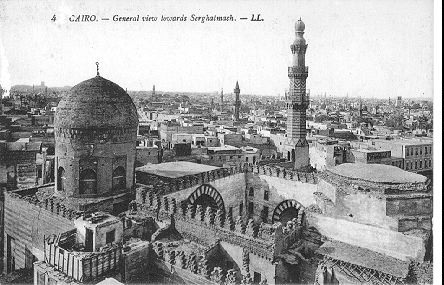
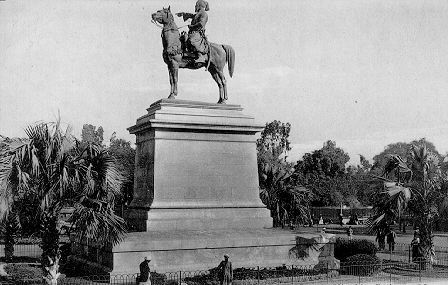 ObaidaIla,
founder of the Fatimid Dynasty, never reached Egypt. But under his great-grandson,
EI Muizz, Gohar set out (A.D. 969) and, almost without resistance, captured
Alexandria and Fustat (Old Cairo). He built a new capital, the Cairo of
today, and enforced the rule of EI Muizz throughout the land. The
Fatimid Khalifs reigned until 1171 and their empire included Northern Africa,
Syria, Sicily and other islands. Hakim, one of these Khalifs, is responsible
for the creation of the religious sect of the Druzes, numerous in Syria
and the Libanon. His end was as mysterious as his life was strange. He
rode out one night towards the Mokattam Hills and was never seen again.
During the troubled years of the Fatimid Dynasty the Crusades began. Nur
el Din, Sultan of Syria, invaded Egypt to avert an invasion by Amalric,
King of Jerusalem. Adid, last of the Fatimids, died soon afterwards and
on his death Saladin, nephew of Nur el Din, governed in his uncle's name
and, on the latter's death, proclaimed himself Sultan of Egypt (1171-1193).
ObaidaIla,
founder of the Fatimid Dynasty, never reached Egypt. But under his great-grandson,
EI Muizz, Gohar set out (A.D. 969) and, almost without resistance, captured
Alexandria and Fustat (Old Cairo). He built a new capital, the Cairo of
today, and enforced the rule of EI Muizz throughout the land. The
Fatimid Khalifs reigned until 1171 and their empire included Northern Africa,
Syria, Sicily and other islands. Hakim, one of these Khalifs, is responsible
for the creation of the religious sect of the Druzes, numerous in Syria
and the Libanon. His end was as mysterious as his life was strange. He
rode out one night towards the Mokattam Hills and was never seen again.
During the troubled years of the Fatimid Dynasty the Crusades began. Nur
el Din, Sultan of Syria, invaded Egypt to avert an invasion by Amalric,
King of Jerusalem. Adid, last of the Fatimids, died soon afterwards and
on his death Saladin, nephew of Nur el Din, governed in his uncle's name
and, on the latter's death, proclaimed himself Sultan of Egypt (1171-1193).